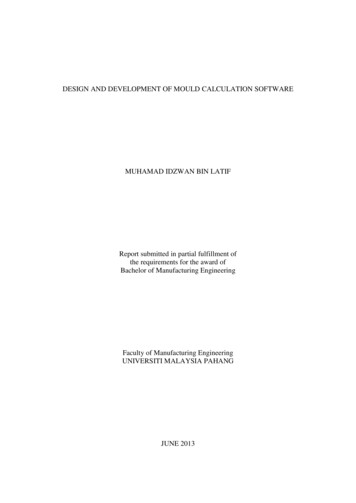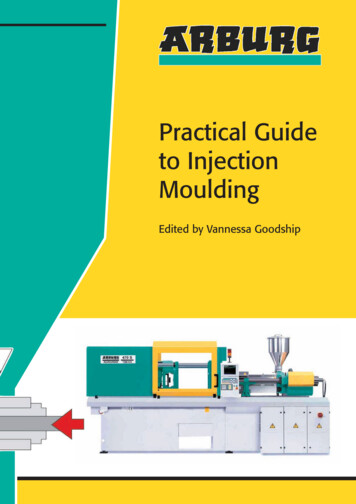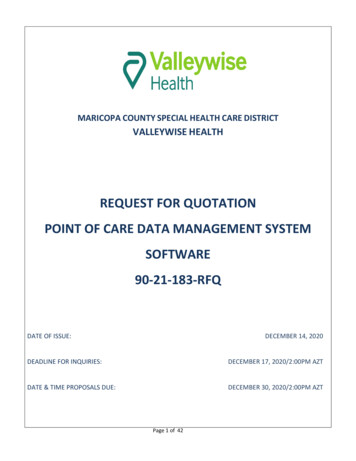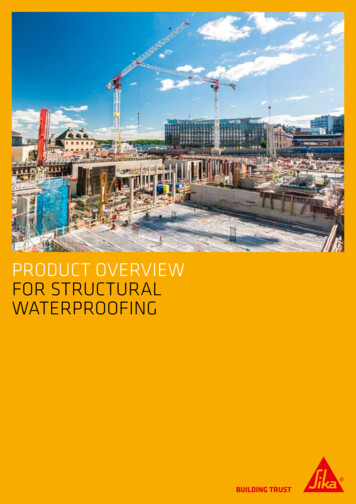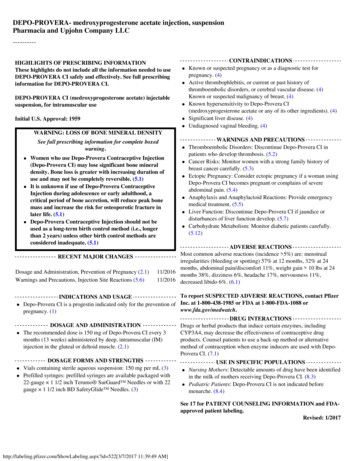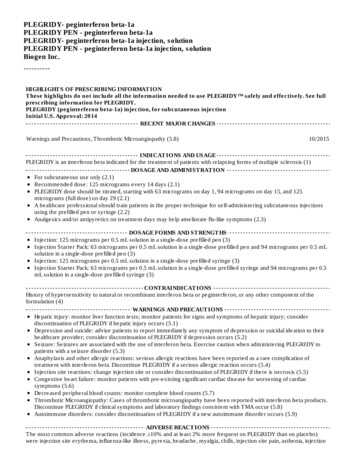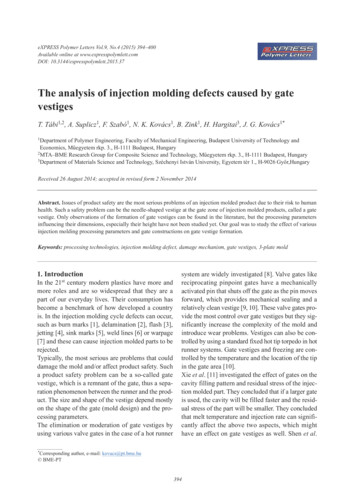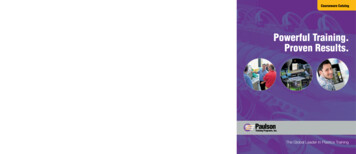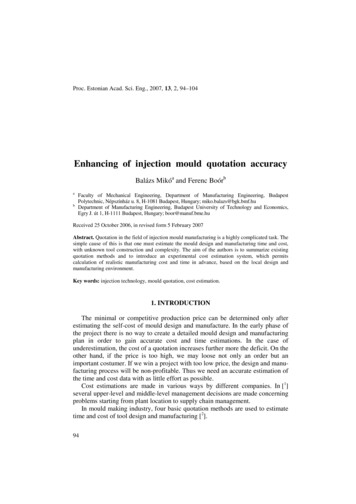
Transcription
Proc. Estonian Acad. Sci. Eng., 2007, 13, 2, 94–104Enhancing of injection mould quotation accuracyBalázs Mikóa and Ferenc BoórbabFaculty of Mechanical Engineering, Department of Manufacturing Engineering, BudapestPolytechnic, Népszínház u. 8, H-1081 Budapest, Hungary; miko.balazs@bgk.bmf.huDepartment of Manufacturing Engineering, Budapest University of Technology and Economics,Egry J. út 1, H-1111 Budapest, Hungary; boor@manuf.bme.huReceived 25 October 2006, in revised form 5 February 2007Abstract. Quotation in the field of injection mould manufacturing is a highly complicated task. Thesimple cause of this is that one must estimate the mould design and manufacturing time and cost,with unknown tool construction and complexity. The aim of the authors is to summarize existingquotation methods and to introduce an experimental cost estimation system, which permitscalculation of realistic manufacturing cost and time in advance, based on the local design andmanufacturing environment.Key words: injection technology, mould quotation, cost estimation.1. INTRODUCTIONThe minimal or competitive production price can be determined only afterestimating the self-cost of mould design and manufacture. In the early phase ofthe project there is no way to create a detailed mould design and manufacturingplan in order to gain accurate cost and time estimations. In the case ofunderestimation, the cost of a quotation increases further more the deficit. On theother hand, if the price is too high, we may loose not only an order but animportant costumer. If we win a project with too low price, the design and manufacturing process will be non-profitable. Thus we need an accurate estimation ofthe time and cost data with as little effort as possible.Cost estimations are made in various ways by different companies. In [1]several upper-level and middle-level management decisions are made concerningproblems starting from plant location to supply chain management.In mould making industry, four basic quotation methods are used to estimatetime and cost of tool design and manufacturing [2].94
The first method is known as intuitive estimation since it is based on thepersonal experience. The application of this method needs a lot of experience anddeep knowledge on the design and manufacturing environment. A junior expertcan estimate the real data with a huge error that can exceed 50%.The second method is called analogue estimation, which uses time and costdata of previous mould productions. This method is more reliable than theintuitive one, if a large database is available. Even with using a computerprogram for evaluations with this method, the cost expert must have a deepknowledge about previous mould constructions and manufacturing processes.The previously produced documents about mould design and manufacturing mustbe well maintained. This method cannot be applied in case of relatively newmould types for which past experience is missing. The accuracy of the analogueestimation method can usually achieve 35% [2].The third method is called parametric estimation; it utilizes some selectedproduct design parameters, which are essential in cost and production timeestimation. Mostly the overall mass of the product or global dimensions are used,but also some more complicated and sophisticated graphical and calculationmethods are used (without essential benefit to the estimation accuracy). Thismethod is applicable only for rough calculation [2,3].The fourth method is analytic estimation, in which case the object is dividedinto components and this method determines cost and time data for the simplifiedcomponents. Using this method, the engineer must have a deep knowledge inmould design and technology in order to identify the essential features anddivision borders. The method is very time-consuming, but an expert user withspecial skills and experience can achieve the level of estimation accuracy 5%,while a beginner can achieve only 15% [2].The quality of the estimation depends on the experience and background ofthe user of the described methods.Table 1 shows the advantages and disadvantages of the cost estimationmethods. Based on these considerations we can determine the features of an idealquotation system: it must be easy to use, must require short processing time, shouldyield accurate results with consideration of current and actual design and manufacturing environment and the results must not depend on the user’s experience.In [4] a parametric cost estimation system for die casting is described; the costis in direct proportion to material cost. In [5] the parametric method is used forthe estimation of the mould cost. The relation between cost and productTable 1. Advantages and disadvantages of known cost estimation gueParametricAnalyticFast, easy-to-useEnvironment orientedFast, simpleAccurateExperience-based, inaccurate, non-consistentTime-consuming, huge databaseInaccurate, heuristicTime-consuming, experience-based, sophisticated95
complexity is investigated in [6] using the parametric method. In [7] a modification of the analogue method is used; an artificial neural network is used forsimilarity estimation. Chin and Wong developed a rule based expert system,which can divide the mould making project to sub-processes [8].2. THE ECOTEST/MOULD COST ESTIMATION SYSTEMFollowing [3], a method, based on an artificial neural network, is proposed fortime and cost estimation in plastic injection moulds design and manufacturingprocess. The proposed expert system creates relationships between the essentialfeatures of the product and the estimated time and cost data. This system reusesthe post-processed cost data of complex moulds and determines the hiddenrelationships between the characteristic features of the part and overall cost(Fig. 1). The artificial neural network is a tool for computational tasks, which hasbiological analogy. An artificial neural network is a hierarchical net of simpleelements which are called nodes (Fig. 2) [9].A perceptron-based neural network is used, where the nodes summarize theweighted inputs and transform them into a non-linear function. If three layers ofnodes are created, where the first contains the input data, the third representsoutput data and the relationship is determined by the learning process itself.Fig. 1. Concept of the ECoTEst MOLD.96
Fig. 2. Perceptron-based artificial neural network.The learning process needs a case base, which consists of post-calculated timeand cost data of moulds. The usage of this data has several advantages. On onehand, these moulds were designed and manufactured by the given (i.e. user)company, so they contain the in-house effects and particularities of the designand manufacturing process. This fact ensures that the actual design and manufacturing environment is considered. Production of a mould needs different timeand cost in different mould shops, because the skills of the employees, qualityand number of machine tools are different.The post-calculated data has other advantages as well. These moulds havealready been produced, therefore the cost and time data are absolutely exact andthere is no need to use theoretical formulas. The post-calculated data containsalso the cost of correction of the manufacturing failures, which can be interpretedas a disadvantage. The manufacturing failures are stochastic, their importanceand cost cannot be forecasted, and so the correction of measured data is neededin order to eliminate random effects. But considering manufacturing processes ofseveral moulds, the average cost of repairing is relatively constant. This valuecharacterizes the technical and human state of the mould shop and this is animportant indicator.One of the most important problems is the content of the learning case base.In the installation phase of the project, the system must be adjusted by thesystematic learning process.It is not practical to exclude non-typical moulds or moulds that had too manymanufacturing problems, because they can cause distortion of the results. Wemust create a most heterogeneous case base, because the extrapolation skill of thenet is rather weak.The learning process needs about 80–100 implemented cases for installation;thus it can perform properly on an annual production of a middle size mouldshop. After installing EcoTEst, in the beginning (maximum for a year) it isrecommended to use the system as an alternative or background solution parallelwith one of the above-listed methods, to control and compare the results and to97
complete the case base with new post-calculated data. When the system containsabout 200 cases, it is able to learn efficiently.It is suggested to supplement the case base with new post-calculated projectresults and to execute new learning process once or twice a year. Such amaintenance ensures the continuous evolution of the accuracy and the capacity ofthe system.3. INPUT/OUTPUT PARAMETERSOne of the most important steps of the system development process is thedefinition of the input and output parameter set. The output parameter set can bedefined rather simply, because it is determined by the time and cost datarequired. The needed data is as follows: Total cost of the project Material cost Design time and cost of the mould Time and cost of process planning and NC programming Time and cost of manufacturing grouped by machines (milling, turning,grinding, EDM, drilling etc.) Time and cost of fitting and assemblyThe selection of input parameters is a more difficult problem. The reason forthat is that the selected parameters must satisfy several conflicting conditions.One can only use such parameters, which can be determined from the representation of the design like 2D drawing, physical model, 3D CAD model in anyformat, etc. Every essential property of the products must be selected, which hasessential effect on the mould structure, size and complexity. The concept of themould must be developed during quotation, and some characteristic propertiesmust be taken into account to obtain accurate results. One of the most importantviewpoints in the parameter selection is the clear structure and avoiding a toolarge number of parameters. Based on these rules, the input parameters are asfollows.Global/overall dimensions of the productOne of the most significant parameters is the maximal dimension of the part.The part’s height, being parallel to the mould open-close direction, influences theheight of the mould. The dimensions normal to the mould height influence theclosing force required and the injection machine.Mass of the productThe mass of the product determines the material cost of the elastic or plasticpart and influences the mould machine selection.98
Number of cavitiesWith higher number of cavities a higher productivity of the mould can beobtained; however, the cost of mould making is also larger. The operation of amulti-cavity mould requires a moulding machine, which is able to ensure theneeded force.Complexity of the productThe complexity of a part is a sophisticated term, not easy to define. In theECoTEst system this parameter is defined in a scale from 1 to 10, where 1 meansthe simplest and 10 the most complicate mould structure. These categories canmean different mould structures in each mould shop, so during installation thecase studies must be included to support users. One should not use the minimumand maximum values of the scale in the beginning, because in the future costestimation for more simple or more complicated moulds may be needed.Estimated overall size of the mouldBased on parameters, mentioned above, the overall size of the mould (Fig. 3)is estimated; it is appropriate to use standard plate dimensions of the material inorder to reduce material cost.Complexity of the mould structureComplexity of the mould structure is scaled from 1 to 10 similarly to theproduct. The mould structure is simple if it consists only of core and cavity platesand the dividing surface is flat, while a multi-cavity mould with sliders, lifters,two-step ejections and threaded insert means very high complexity.Fig. 3. Overall schema of a mould.99
Type of the runner systemAn injection mould has a standard runner surface or a hot runner system(Fig. 4). A standard runner surface is more simple and cheaper to manufacture,but the time of an injection cycle is longer and provides significantly morematerial wastes. Although applying a hot runner system leads to shorter cycletime and nearly zero material waste, it is considerably more costly.Complexity of sliders and liftersThese parameters characterize the geometric complexity of sliders and liftersin a scale from 1 to 10.Quantity of sliders and liftersSliders and lifters form undercut surfaces, which cannot be formed only by acore and cavity (Fig. 5). Application of more sliders means higher mouldcomplexity, more components, and so the cost of the design, process planningand manufacturing will be higher (this parameter is also scaled from 1 to 10).Quantity of deep ribs and cavitiesDeep ribs and cavities increase the cost of a mould as they can not bemachined by milling but on EDMs. The additional cost appears both in theplanning and manufacturing phase (the parameter is scaled from 1 to 10).Quantity of EDMed surfacesOne has to determine surfaces, which cannot be manufactured on a millingmachine, but only on an EDM, because of their shape (weak walls) or material(also scaled from 1 to 10).Fig. 4. The hot runner system.100
Fig. 5. A slider and a lifter.There are several reasons why the application of the EDM technology increasesthe manufacturing cost. First of all, EDM technology requires electrodes, whichdemands additional tool design and process planning and manufacturing. Secondly,the EDM process has low productivity. Thirdly, if the product’s surface requirements do not allow EDMed surface quality, the surface finishing demandsadditional manual manufacturing.Quality of the product’s surfaceThe product surface must meet design requirements, functionality and manufacturability. The surface structure and quality depend on the mould’s manufacturing process. If necessary, this structure can be eliminated by manualmanufacturing or super-finishing.In certain cases the costumer requires special surface structure like leatherdesign. This structure can generally be manufactured by EDM. The surface canbe machined also by electrochemical machining, which needs many manual preprocesses (e.g. the milling paths or the EDMed hard surface layer must beremoved).Heat treatment requirementsCertain product parts need heat treatment that leads to additional cost andproduction time as well as to additional transportation, if the heat treatmentcannot be managed in the mould shop.101
In the cost estimation system there are three types of parameters to bedistinguished. The first type are exact numerical values such as overall dimensionsof the part. The second type of parameters can be generated from the mould’srequirement list, for example from the heat treatment requirements or type of therunner system. The parameters of the third type have subjective values, likecomplexity of the mould structure. The effect of subjectivity can be reduced by auser’s manual, where the selected values can be illustrated by examples.Interpretation and specification of input parameters require perfection in themould design. The conceptual mould design is also required in advance, as theoverall size of the mould, the number of lifters and sliders can not be definedwithout that.4. AN INDUSTRIAL EXAMPLEFigure 6 shows one of the test parts, a handle frame. The overall dimensionsof the part are 265 110 45 mm, the material of the part is ABS/PC, andbecause of there are no undercuts, the mould has a simple structure (open/close,no sliders and lifters). The required number of the cavities is 1, and the customerrequired a simple runner system. There are no undercuts, but there is a lot of ribs,which increase the complexity of the part. The visible surfaces need a fineEDMed structure. Table 2 shows the case file of this mould.Based on industrial practice we processed about 100 cases. During the dataprocessing we collected various cases, several products have more than onemould with different runner systems and different numbers of cavities; thus theeffect of these parameters is well represented. This case base is suitable fordeveloping and for the ANN-based learning process. Of course it can be used inthe study of the case-based reasoning approach of mould quotation.Fig. 6. Handle frame.102
Table 2. An industrial example103
5. CONCLUSIONSIn the case of conventional cost estimation methods, the accuracy and theproductivity are somewhat contradictory. The ANN is not a mere means ofestimation, but also suitable for resolving conflicts. Based on the local case base,the ANN can create the tailor-made relationship between the product and themanufacturing time and cost required.REFERENCES1. Ben-Arieh, D. and Lavelle, J. P. Manufacturing cost estimation. J. Eng. Valuation Cost Anal.,2000, 3, 43–55.2. Dealey, W. Mold quoting: The magic, art and science. Modern Mold Tooling, 2001, 3, 10–18.3. Mikó, B. and Szántai, M. Artificial intelligence methods in early manufacturing time estimation.In Proc. Third Conference on Mechanical Engineering. Budapest, 2002, 535–539.4. Lenau, T. and Egebøl, T. Early cost estimation for die casting. In Proc. International Conferenceon Engineering Design. Praha, 1995, 1007–1016.5. Chan, S. F., Law, C. K. and Chan, K. K. Computerised price quotation system for injectionmould manufacture. J. Mater. Process. Technol., 2003, 139, 212–218.6. Fagade, A. A. and Kazmer, D. O. Modelling the effects of complexity on manufacturing costsand time-to-market of plastic injection molded products. In Proc. 10th Annual Conferenceof the Production and Operations Management Society. Charleston, 1999, CD.7. Wang, H., Zhou, X. H. and Ruan, X. Y. Research on injection mould intelligent cost estimationsystem and key technologies. Int. J. Adv. Manufact. Technol., 2003, 3, 215–222.8. Chin, K-S. and Wong, T. N. An expert system for injection mold cost estimation. Adv. PolymerTechnol., 1995, 14, 303–314.9. Shepanski, J. F. Artificial neural systems. In Encyclopedia of Physical Science and Technology,vol. 2. Academic Press, New York, 1992, 65–77.Survevaluvormi hinnapakkumise täpsuse suurendamineBalázs Mikó ja Ferenc BoórSurvevaluvormi valmistamise hinnapakkumise koostamine on keeruline ülesanne ja selle metoodika väljatöötamine on suureks väljakutseks nii tööriista- kuika plastdetailide valmistajatele. Tööriistavalmistajatele on probleemiks erinevused tegeliku ja arvutatud aja ning maksumuse vahel, mis on saadud kehtivaidreegleid järgides või hinnatud katseliselt. Hinnata tuleb valuvormi projekteerimise ja valmistamise hinda ning aega, tuginedes plastist toote andmetele, ilma etoleks teada valmistamise tehnoloogia, tööriista struktuur ja keerukus. Artiklieesmärgiks on analüüsida olemasolevaid hinnapakkumise koostamise meetodeidja tutvustada eksperimentaalse hinnapakkumissüsteemi kontseptsiooni, mis võimaldab arvutada reaalset pressvormi valmistamise aega ning maksumust kiiremini ja täpsemalt, arvestades ettevõttes kehtivat projekteerimise ja valmistamisekeskkonda.104
Abstract. Quotation in the field of injection mould manufacturing is a highly complicated task. The simple cause of this is that one must estimate the mould design and manufacturing time and cost, with unknown tool construction and complexity. The aim of the authors is to summarize existing
